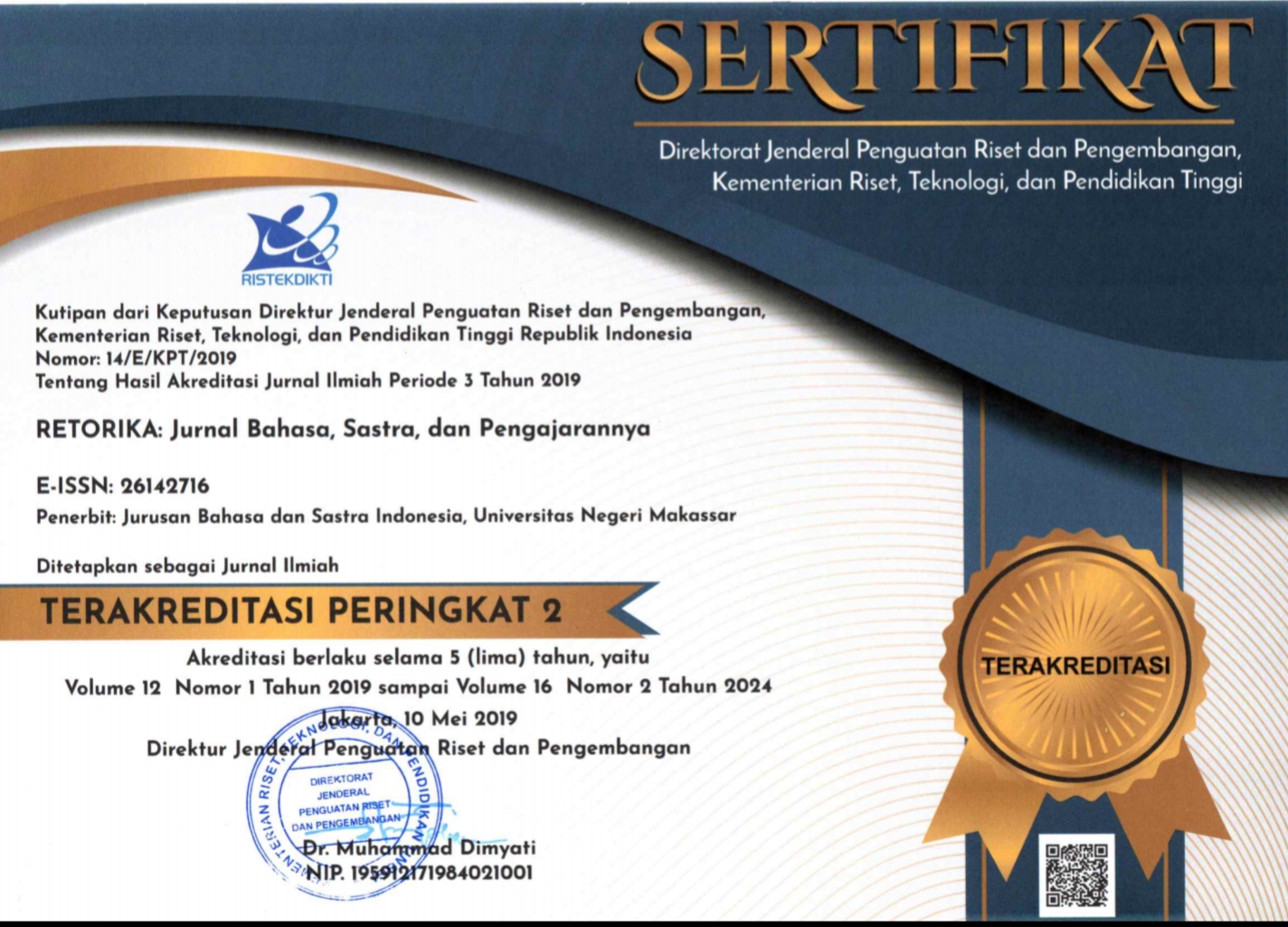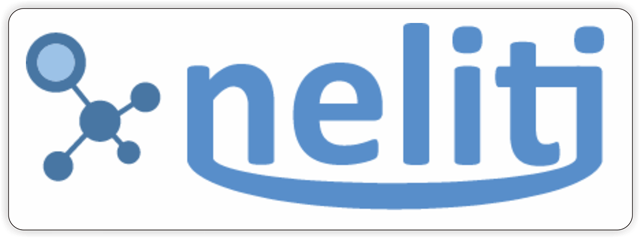Author Guidelines
1. Manuscripts should include research findings related to Indonesian language teaching and Indonesian language and literature
2. Manuscripts are free from plagiarism practices and have not been published and are not under consideration for publication elsewhere. Authors hoping to submit their articles to RETORIKA have to sign a statement which declares such a thing. Please download the Declaration Form.
3. Manuscripts are written in Bahasa Indonesia and they should range from 4.000 to 6.000 words.
4. All submissions must be word processed in A4 (21 x 29,7 cm) Times News Roman, single spaced. Paper margins should be set as 2,5 cm (left) and 3 cm (top, bottom, and right).
5. Prior to submitting an article through the online submission system, authors are required to register first and then follow five steps of article submission.
6. The systematic of the manuscripts consist of: title, authors name, authors affiliation, and authors affiliation address, main author’s email, DOI (provided by the editors), abstract and keywords, introduction, method, research findings and discussion, conclusion, and references. Please download article template.
7. Manuscripts’ titles must be capitalized, centred, 14 points, and bold. Titles written in Bahasa Indonesia must not exceed 12 words and titles written in English must not exceed 10 words. Formal heading sections must be written as follows.
LEVEL 1 (ALL CAPITALIZED, JUSTIFY, BOLD)
Level 2 (Title Case Capitalization, Justify, Bold)
Level 3 (Title Case Capitalization, Justify, Bold, Italic)
8. Authors’ names must not be attached by an academic title and put under the manuscript title. If the manuscript is written by a team, all names must be mentioned. Authors whose names mentioned are only those with significant contribution. Authors name should be sorted based on their contribution in writing the manuscript. Editors will only communicate with the main author whose name is mentioned first.
9. Abstracts and keywords must be written in 80—100 words, both in Bahasa Indonesia and English with a single space. Abstracts should contain research title, objectives, method, findings, discussion, and conclusion. There should be 3-5 keywords describing the manuscript substances. Keywords should not be part of the manuscript title.
10. Introduction contains background of the study, context of the study, review of main literature underlying the research, and research aims. Authors are strongly recommended to refer to the most recent articles published by reputable journals. Introduction must be presented in paragraphs. Introduction should be 15—20 % of the manuscript length.
11. Research method contains the explanation of methods used by the researchers to generate findings. This part must present scientific research procedures conducted by the researchers. Method also contains research approach and methods, source of data/population and sample, sampling technique, instrumentation and data collection method, and technique of data analysis. The length of this part should be around 10—15 % of the total manuscript.
12. Research findings and discussion contains interpretation based on research objectives. Describe research findings according to the objectives or problems of the research. Research findings must be discussed, interpreted, and compared with previous related theories and research findings. Discussion must indicate the novelty and significance of the findings. Discussion constitutes the most important part of the article so that authors need to provide clear and complete explanation to it. The length of this part should be around 50—60 % of the total manuscript.
13. Conclusion contains research findings and the summary of the discussion. Conclusion is presented in paragraphs. Write the substantial findings concisely. Give recommendations for future researchers related to research follow-ups. Conclusion is 5—10% of the total length of the manuscript.
14. References should include the most recent publication (80% of them should not be dated more than 10 years). Primary sources such as journal articles and research reports including undergraduate theses, master theses, and dissertations are most welcomed. Manuscripts published in accredited national and international journals should be more prioritized.
15. Citations, references, tables, figures, illustrations, statistics, and bibliography writing should refer to Publication Manual of the American Psychological Association (6th edition) and APA Style Guide to Electronic References. Manuscripts written in Bahasa Indonesia should be referred to Pedoman Umum Ejaan Bahasa Indonesia dan Istilah yang telah dibakukan.
16. Use caged referral technique (last name, year) to write references. In-text citations should include page numbers and sources.
Examples:
One author: According to Fairclough (2010:99) or.... (Fairclough, 2010:99).
Two authors: According to Kalantzis & Cope (2012:129) or.... (Kalantzis & Cope, 2012:129)
Three authors: According to Miles, Huberman, & Saldana (2017:10) or.... (Miles, Huberman, & Saldana, 2017:10).
More than three authors: According to Sultan, et al. (2017) or.... (Sultan, et al., 2017)
17. References should be ordered alphabetically and chronologically and written as follows.
Books:
Hopkins, D. 2011. A Teacher Guide to Classroom Research. New York: McGraw Open University Press.
Translated Books:
Anderson, L.W. & Krattwohl, D. R. 2001. Kerangka Landasan untuk Pembelajaran, Pengajaran, dan Asesmen: Revisi Taksonomi Pendidikan Bloom. Diterjemahkan oleh Agung Prihantoro. 2010. Yogyakarta: Pustaka Pelajar.
Manuscripts in compilation books:
Sugono, D. 2007. Perencanaan Bahasa Indonesia dan Memasuki Globalisasi. Dalam Anshari dan Mahmudah (Eds.), Budi Bahasa (hlm.1—14). Makassar: Badan Penerbit UNM.
Manuscripts in journals:
Sultan. 2010. Gaya Bahasa Guru dalam Interaksi Pembelajaran. Jurnal Penelitian Pendidikan Insani, 11 (2): 82-89.
Manuscripts in electronic journals with DOI:
Sultan, Rofiuddin, A., Nurhadi, Priyatni, E. T. 2017. The Development of Critical Reading Learning Model to Promote University Students’ Critical Awareness. New Educational Review, 48(2):76–86, doi: 10.15804/tner.2017.48.2.06
Manuscripts in newspapers:
Agustien, H. I. R. 1 Maret 2013. Bahasa Indonesia Berbasis Genre, Kompas, hlm. 6.
Undergraduate Theses, Master Theses, Dissertations, Research Reports:
Saleh, M. 2009. Representasi Kesantunan Berbahasa dalam Wacana Akademik: Studi Etnografi di Universitas Negeri Makassar. Disertasi. Malang: PPs UM Malang.
Papers presented in Seminars, Discussions, Workshops, and Training:
Taha, Z. 2012. Etiket dan Kesantunan dalam Berbahasa Bugis. Makalah disajikan dalam Kongres International II Bahasa Daerah di Sulawesi Selatan, Hotel Sahid Makassar, 1—4 Oktober 2012.
Internet (manuscripts in online journals):
Widodo, A. 2006. “Profil Pertanyaan Guru dan Siswa dalam Pembelajaran Sains”. Online. Jilid 4 Nomor 2, http://upi.edu, diakses: 20 Maret 2012.
18. Manuscripts are reviewed anonymously by the reviewers who have been assigned according to their expertise. Authors are given an opportunity to revise the manuscripts based on the reviewers or editors recommendations. Authors will receive written receipt of information related to the acceptance or disapproval of the manuscript.
19. Authors are responsible for anything related to the permission of citing or using a computer software during the manuscript writing as well as used intellectual properties and their legal consequences.
20. Authors are required to check and edit errors in language use including vocabulary, sentence structure, capital letters, and punctuation prior to submission. Authors can refer to the previous published articles to adjust theirs with the journal writing style.



 Email: retorika@unm.ac.id
Email: retorika@unm.ac.id













